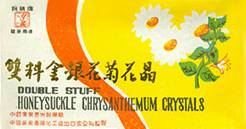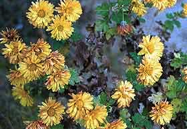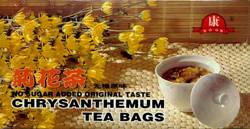Chrysanthemum and Chamomile: Flower Teas
Flowers are a valuable ingredient for making herbal teas. The two most popular teas with flowers used as single herbs are chamomile in the West and chrysanthemum in the East. Other flowers, such of hibiscus, rose, lavender, orange, and tilia (linden), are used as flavor ingredients for a wide range of herbal beverage teas, while jasmine and osmanthus flowers impart an exotic flowery taste and aroma to green tea.
Both chamomile and chrysanthemum are in the same plant family: Asteraceae. There are two types of chamomile commonly used for teas, the “true” chamomile, or German chamomile, Matricaria recutita, which is most widely used and the basis of descriptions of chamomile below, and Roman chamomile, Chamaemelum nobile. There are also two basic types of chrysanthemum used in China (among several distinguished varieties): the standard herb, Chrysanthemum morifolium (known simply as juhua) and the “wild” chrysanthemum, Chrysanthemum indicum (yejuhua). The British doctors Smith and Stuart, who were working in China at the end of the 19th Century, observed that for chrysanthemum “some difference is made by the Chinese in the uses of different varieties, although their therapeutic action is regarded as practically identical....any of these varieties, and especially ganju, will make a good substitute for chamomile (1).”
In the modern Chinese Materia Medica guides, chrysanthemum is listed among the cooling herbs for “relieving the surface” (or “releasing the exterior”), yet this placement may obscure the fact that the flowers have also been utilized to promote circulation, preserve vitality, and provide some properties akin to those of the tonic herbs. These aspects were relayed in Shennong Bencao Jing (2): “protracted taking may disinhibit the blood and qi, make the body light, slow aging, and prolong life.” In the book Maintaining Your Health (3), the Chinese tonic herbs are the primary ones described for long-term use with health protecting effects, but there is also an addendum listing fourteen herbs from other categories, including chrysanthemum:
Sweet, bitter, and cool-natured, chrysanthemum (juhua) has the potency to expel wind, clear away heat, calm the liver, improve acuity of sight, subdue inflammation, and expel toxic substances, and it has been used as an exterior syndrome relieving herb, pungent in flavor and cool in property, to treat wind-heat syndrome due to external pathogen, furuncle, carbuncle, and swelling. Recently, it has been used to treat coronary heart disease and hypertension. Research has shown that the main active principles of chrysanthemum [….with example given….] ensure the following pharmacological actions: improving the function of the cardiovascular system, preventing thrombosis, preventing and treating cardiovascular diseases, reducing fever, tranquilizing the mind, inhibiting bacteria, combating virus, retarding the onset of senility, and enhancing longevity.
Historically, chrysanthemum as a wine was one of the principal means of gaining long-term health-promoting properties (that is, other than dispelling wind-heat); for example, Smith and Stuart noted that the wine was “considered beneficial in a great variety of digestive, circulatory, and nervous afflictions.” Western herbalists considered chamomile as tonic and sedative (for nervous afflictions), and it is also considered of value for digestion. So, we see a somewhat parallel development for these two mild herbs arising from different traditions.
Varieties
Chrysanthemum (juhua) has been cultivated since ancient times as a decorative plant, and so the designation of another species as “wild” (yejuhua) is in contrast to the garden variety, but in modern China both medicinal varieties are obtained in large quantities from cultivated plants. Yang Yifan (4) describes the main types based on color (bai = white; huang = yellow); taste (gan = sweet), and source (ye = wild variety), starting with the standard Chrysanthemum morifolium
There is huangjuhua, the yellow flower, which is sometimes called hangjuhua, as it comes from Hangzhou....Huangjuhua especially enters the lung meridian; it is more effective for expelling wind-heat in the upper burner and is often used in cold infections, feverish sensations in the head, and headache. It can also be used for acute infections of the eyes, such as acute conjunctivitis...the steam from juhua decoction can be used for painful and itchy eyes...moreover, the cool decoction can be used externally to wash the affected eye.
Baijuhua, the white flower, is also called ganjuhua, which means sweet juhua. It is also sometimes call chujuhua because the white juhua growing in Chu county is considered to have the best quality. Baijuhua is sweeter and cooler [than huangjuhua], and can slightly generate yin and clear heat. Because it enters the liver meridian, it is more effective in cooling and pacifying the liver and benefiting the eyes. It is used for dizziness, blurred vision, dry eyes, and a tired feeling in the eyes, which are caused by yin deficiency or yin deficiency with uprising liver yang....
Yejuhua is bitter and neutral. It can reduce heat and remove heat-poison. It is used for all types of boils, furuncles, and carbuncles with localized erythema, swelling, heat, and pain. This herb can also be used topically; the smashed fresh yejuhua can be applied to the affected region as a compress to reduce swelling and pain...
Thousand Formulas and Thousand Herbs of Traditional Chinese Medicine (5) offers a simplified version of this analysis: yellow chrysanthemum for dispelling wind-heat; white for pacifying liver yang, clearing liver heat, and brightening the eyes, and yejuhua for detoxifying. Aside from the chrysanthemum from Hangzhou or Chu County, other locations that specialize in growing chrysanthemum also label their products; for example Anhui Province is now a major producer, and one of the famous growing regions is Huangshan (Yellow Mountains), so there is huangshan juhua.

 The detoxiant properties of chrysanthemum were captured in the popular Chinese instant tea product called “Double Stuff,” a combination of lonicera and chrysanthemum flowers, used for alleviating severe skin disorders. A “Triple Stuff” formula (Sanhua Cha; three flower tea) is described in the book ChineseMedicinal Teas (6), which additionally contains jasmine flowers; the book also presents herbal teas that combine chrysanthemum flower with morus leaves along with one, two, or three other herbs.
The detoxiant properties of chrysanthemum were captured in the popular Chinese instant tea product called “Double Stuff,” a combination of lonicera and chrysanthemum flowers, used for alleviating severe skin disorders. A “Triple Stuff” formula (Sanhua Cha; three flower tea) is described in the book ChineseMedicinal Teas (6), which additionally contains jasmine flowers; the book also presents herbal teas that combine chrysanthemum flower with morus leaves along with one, two, or three other herbs.


Upper left: Chrysanthemum flowers; this is C. morifolium with yellow flowers. Upper middle: ready-to-drink chrysanthemum tea in a can. Upper right: “double stuff” instant tea crystals (sugar base). Lower left: one of many packaged chrysanthemum products for making tea from the flowers; this one contains both chrysanthemum and chamomile with a green tea base.
Chrysanthemum Active Components
The chemical constituents of chrysanthemum flowers that contribute to its therapeutic action are complex; two major groups of compounds have been identified: flavones, dominated by acacetin, and essential oils, dominated by sesquiterpenes. Acacetin is a methylated form of apigenin, a well-known medicinal plant constituent, and the primary flavone of chamomile; chrysanthemum flowers also contain apigenin and luteolin (another apigenin-like flavone found in chamomile). The essential oils in chrysanthemum include borneol, camphor, and cineole, as well as other aromatic compounds (including several sesquiterpene lactones; chamomile also contains terpenes, but different ones). The flavones are considered valuable for promoting circulation; they may also have a role in protecting the lens of the eye in diabetic patients (by inhibiting the enzyme aldose reductase). The essential oils have antimicrobial activity (7) and may explain the use of chrysanthemum for treating skin infections (taken orally and applied topically); the herb is considered especially useful for inhibiting staphylococcus. Chrysanthemum flower extracts standardized to total flavone content (up to 30%) are commercially available: these are used in formulating products for cardiovascular health. The yellow color in the flowers is attributed to carotenoids, mainly lutein, which is a visual pigment; interestingly, the Chinese recommendations preferring white chrysanthemum for eye disorders lose the benefit of this component. So, when treating visual disorders associated with retinal pigmentation problems, yellow flowers turn out to be best; the white flowers may have higher amounts of ingredients that would alleviate lens and corneal disorders or retinal disorders associated with impaired circulation.
Chrysanthemum Dosage and Duration of Use
Chinese herbal texts indicate typical range of dosage for chrysanthemum of 5-10 grams per day, sometimes up to 15-30 grams per day. Most formulas for herb teas that rely on chrysanthemum flower as the primary ingredient suggest use of at least 10 grams for one day. In the book Traditional Chinese Treatment for Senile Diseases (8), chrysanthemum flower tea is recommended for alleviating high blood pressure; it is said that it “can be taken for a long time, 6–12 grams per day.” Also mentioned in the book for hypertension is the mixture of chrysanthemum flower and crataegus (shanzha) taken as tea or powdering the herbs and mixing the powder with rice to make a gruel, using 9–12 grams of chrysanthemum flower. Jiao Shude (9) observes that chrysanthemum nourishes the liver and can “be used frequently” (taken over an extended period) with the dosage being generally 6–9 grams, but can be used in doses of 12–15 grams; by contrast, he says that mentha (bohe) does not nourish the liver and so should not be taken for extended periods (for mentha, he indicates a usual dosage of just 1.5–6 grams, up to 9 grams per day). Thousand Formulas and Thousand Herbs of Traditional Chinese Medicine indicates the dosage range of 10–15 grams. In Chinese-English Manual of Common Used Herbs (10), the dosage of chrysanthemum in decoction is given as 3–10 grams, but 10–30 grams for “severe heat cases,” which appears to refer primarily to the treatment of carbuncles and similar infectious diseases that are considered due to “intensive heat.” Chinese Medicinal Herbs of Hong Kong (11) has a listing for yejuhua, and indicates 15–30 grams in decoction. Among the indications are prevention of infectious diseases, including colds, influenza, and epidemic encephalitis. Several texts make little distinction between juhua and yejuhua in terms of use and dosage (having the latter as a subdivision of juhua); in A New Compendium of Materia Medica (12), it is noted that yejuhua has the same applications as juhua except that yejuhua is additionally used for conjunctival hyperemia. The chrysanthemum flowers are of low density, so these dosages involve a substantial volume of herb material.
The low doses of 3–9 grams are mainly used when chrysanthemum is incorporated into complex formulas, and the higher doses of 9–30 grams are for chrysanthemum used as a single herb or in small formulations. The herb is considered non-toxic, but there are rare cases of allergic reaction to plants of this family (Asteraceae), either in the form of contact dermatitis (especially with fresh herb) or response to ingested components. In chrysanthemum, the sesquiterpene lactone arteglasin is considered the main contributor to contact dermatitis (13).
References
- Smith FP and Stuart GA, Chinese Medicinal Herbs, 1973 Georgetown Press, San Francisco, CA
- Yang Shouzhong (translator), The Divine Farmer’s Materia Medica, 1988 Blue Poppy Press, Boulder, CO
- Xu Xiangcai (chief editor), Maintaining Your Health, volume 9 of The English-Chinese Encyclopedia of Practical Traditional Medicine, 1989 Higher Education Press, Beijing
- Yang Yifan, Chinese Herbal Medicines: Comparisons and Characteristics, 2002 Churchill-Livingstone, London
- Huang Bingshan and Wang Yuxia (chief compilers), Thousand Formulas and Thousand Herbs of Traditional Chinese Medicine, 1993 Heilongjiang Education Press, Harbin
- Zong XF and Liscum G, Chinese Medicinal Teas, 1996 Blue Poppy Press, Boulder, CO
- Shunying Z, et.al., Chemical composition and antimicrobial activity of the essential oils of Chrysanthemum indicum, Journal of Ethnopharmacology 2005; 96(1–2): 151–152.
- Hou Jinglun and Geng Xiu’e (chief editors), Traditional Chinese Treatment for Senile Diseases, 1997 Academy Press, Beijing
- Jiao Shude, Ten Lectures on the Use of Medicinals, 2003 Paradigm Publications, Brookline, MA
- Ou Ming (chief editor), Chinese-English Manual of Common Used Herbs in Traditional Chinese Medicine, 1989 Joint Publishing Company, Hong Kong
- Li Ninghon, et.al. (editors), Chinese Medicinal Herbs of Hong Kong, 1986 Chinese Medicinal Research Institute, Hong Kong
- Ling Yeouruenn, A New Compendium of Materia Medica, 1995 Science Press, Beijing
- Tang W and Eisenbrand G, Chinese Drugs of Plant Origin, 1992 Springer-Verlag, Berlin
July 2010